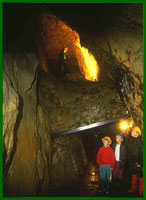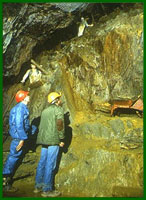 |
|
|||
|
Sygun
Copper
|
History and Archeology The mine changed hands a number of times until Henry McKeller owned it from 1839 until he died in 1862, during which time between 2,000 and 3,000 tonnes of ore had been removed. Again the mine changed hands until it finally closed in 1903. All the plant and machinery was recovered and moved to another mine at Glasdir near Dolgellau. Mining for most of Sygun's history was achieved by miners hand-drilling holes with a hammer and chisel that were subsequently packed with gunpowder and ignited. As they removed the ore and waste rock they left pillars of rock to support the roof and hammered metal pegs into the walls to support wooden ledges or floors to stand on. Waste rock from these higher workings was piled on the timber so the floor rose with the miner. Sygun briefly came to life again in 1958 when it was transformed into a Chinese village for the filming of The Inn of the Sixth Happiness starring Ingrid Bergman, Curt Jurgens and Robert Donat. In 1983 the deep adit was reopened and restoration work started in the autumn of 1985 prior to its opening in 1986.Hundred of tonnes of rubble were removed by hand from abandoned workings, the headroom was raised to improve access, drainage and walkways improved and staircases erected. In 1988 Sygun Copper mine received a Prince of Wales Award and to mark the occasion a copper ingot, refined from Sygun copper ore, was presented to the Prince. The mine also holds a British Tourist Authority Come to Britain Award.
|

 Within
this hillside, several lodes - steeply inclined (or often vertical) veins
or seams of minerals, have been mined for the copper-ore that they contain.
Sygun mines may have had Roman origins because there are remains of a
Roman fort close by. Unfortunately there is little documentary evidence
before 1825 but his is due to lack of records rather than activity. It
is, however, known that in the 18th century more than seventy inhabitants
of Beddgellert were employed in nearby copper mines. At the start Sygun
was reasonably productive because by 1836 ore taken from the mine had
been sold for £2,800 and a crushing mill was subsequently built adjacent
to the Afon Glaslyn.
Within
this hillside, several lodes - steeply inclined (or often vertical) veins
or seams of minerals, have been mined for the copper-ore that they contain.
Sygun mines may have had Roman origins because there are remains of a
Roman fort close by. Unfortunately there is little documentary evidence
before 1825 but his is due to lack of records rather than activity. It
is, however, known that in the 18th century more than seventy inhabitants
of Beddgellert were employed in nearby copper mines. At the start Sygun
was reasonably productive because by 1836 ore taken from the mine had
been sold for £2,800 and a crushing mill was subsequently built adjacent
to the Afon Glaslyn.  The
ore was carried in large buckets called Kibbles to where it could be loaded
into metal tubs to be taken out of the mine on tramways. It was then taken
to the crushing mill before being transported by horse and cart to Beddgelert
and Portmaddog where it was shipped to Swansea for refining into copper
metal. The construction of the railway made the transportation of the
ore considerably easier. Then in the 1890s a revolutionary new process
of ore separation enabled higher percentages of concentrate than had ever
been achieved before. This was achieved in a floatation house where the
valuable ore was trapped in a layer of oil floating on tanks of water
while most of the waste sank into the water. The oil and water were separated
on the next level down. To increase efficiency a horse drawn tramway was
constructed from the Victoria level to the floatation house.
The
ore was carried in large buckets called Kibbles to where it could be loaded
into metal tubs to be taken out of the mine on tramways. It was then taken
to the crushing mill before being transported by horse and cart to Beddgelert
and Portmaddog where it was shipped to Swansea for refining into copper
metal. The construction of the railway made the transportation of the
ore considerably easier. Then in the 1890s a revolutionary new process
of ore separation enabled higher percentages of concentrate than had ever
been achieved before. This was achieved in a floatation house where the
valuable ore was trapped in a layer of oil floating on tanks of water
while most of the waste sank into the water. The oil and water were separated
on the next level down. To increase efficiency a horse drawn tramway was
constructed from the Victoria level to the floatation house.